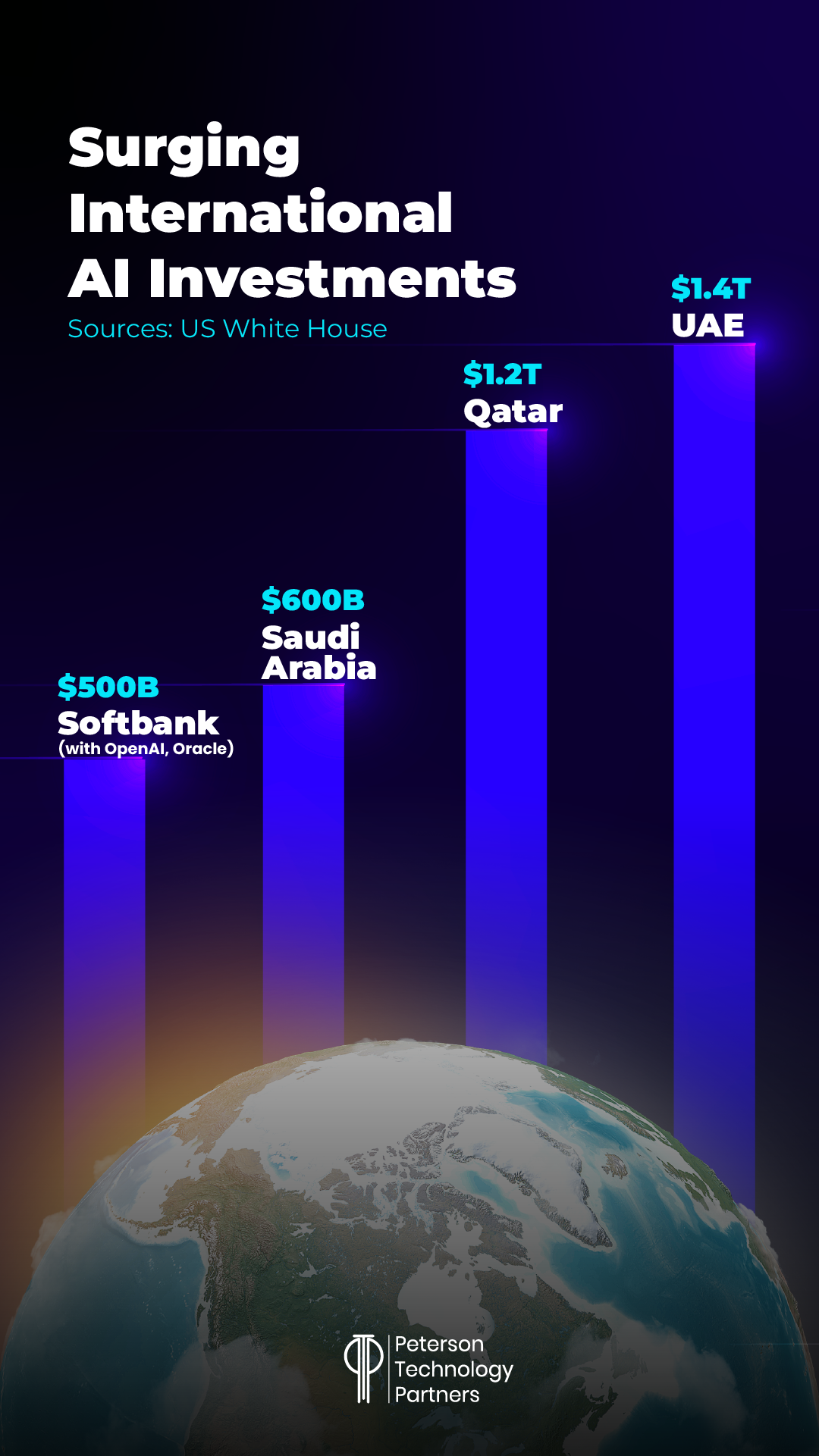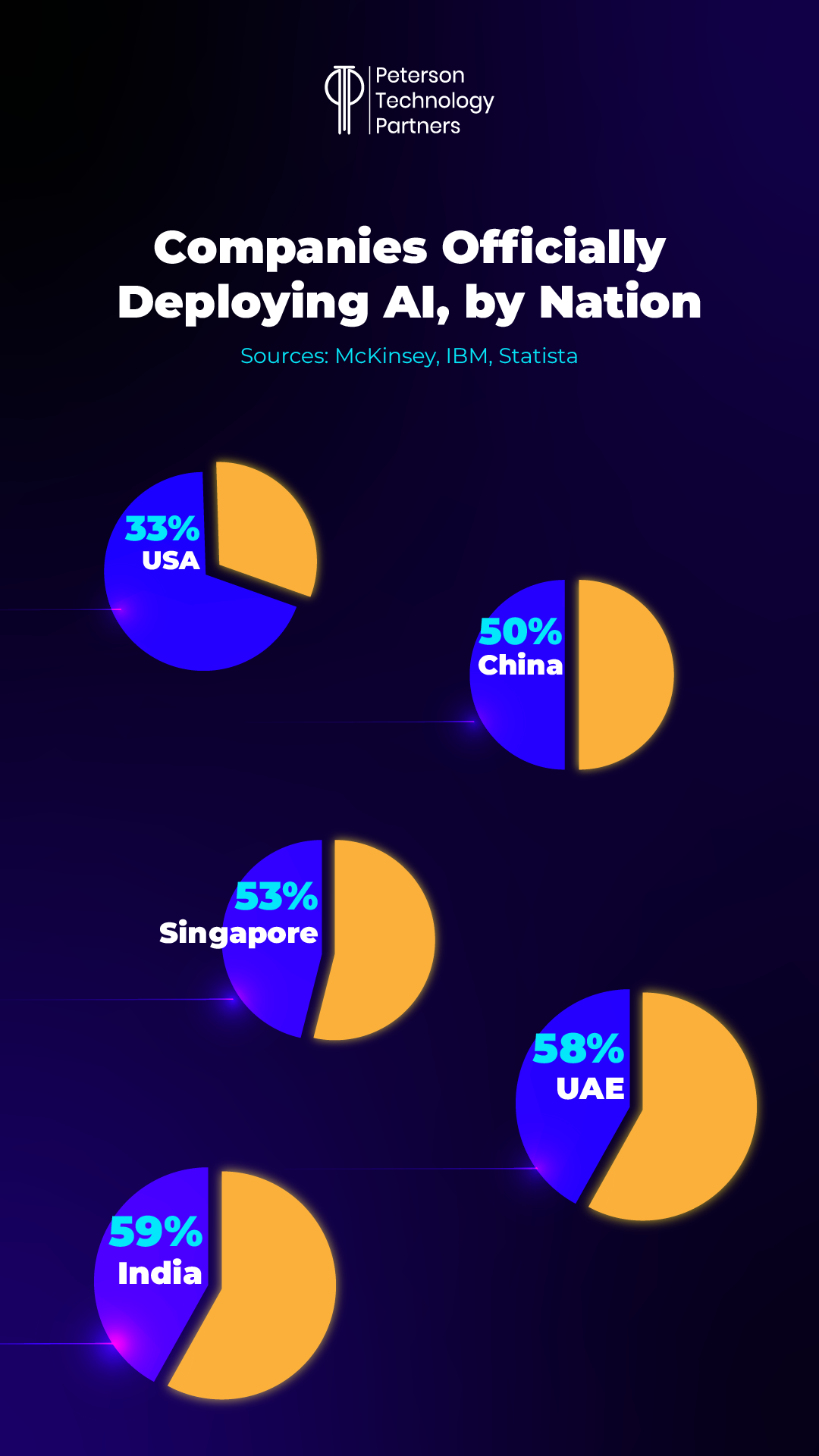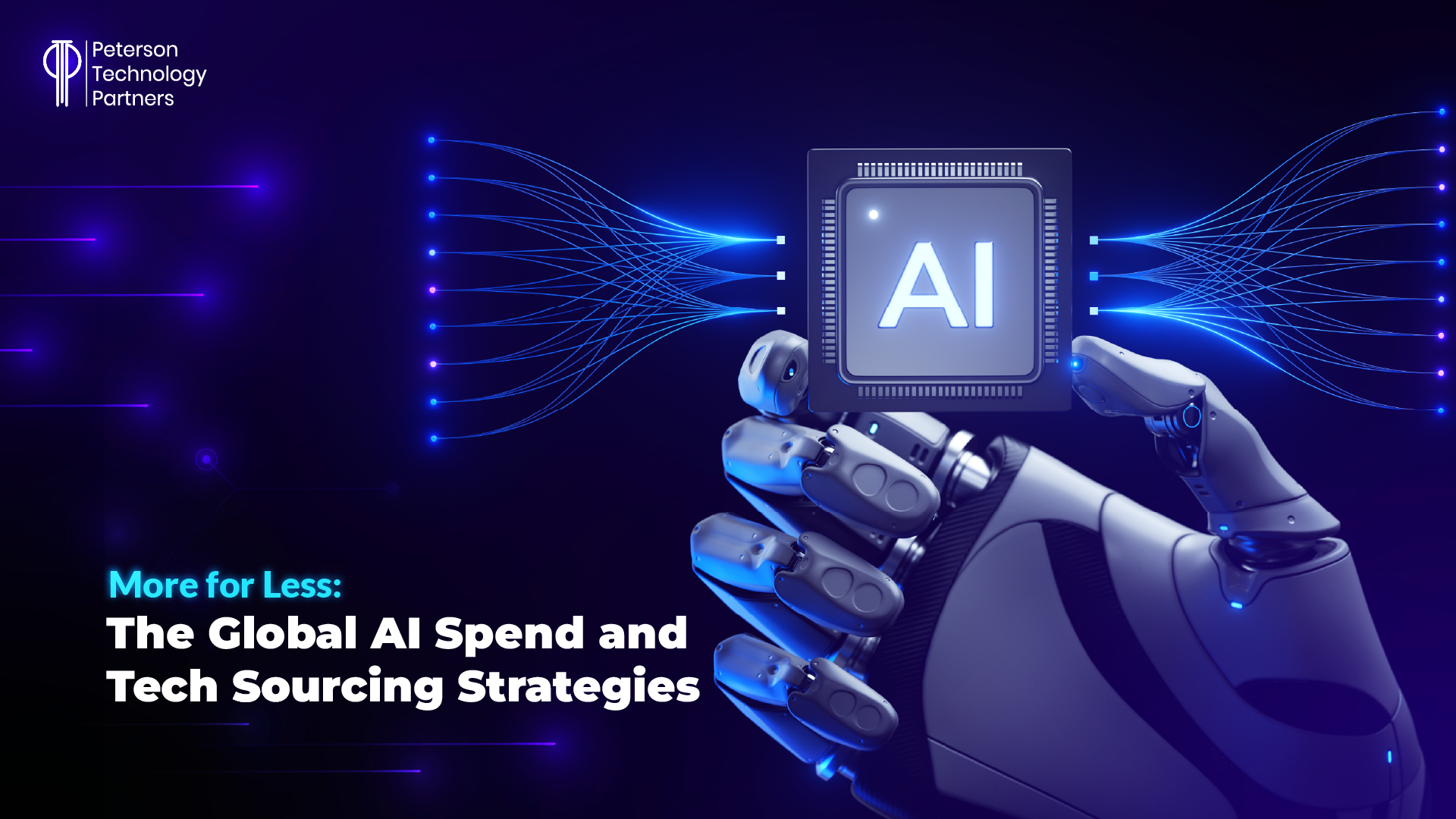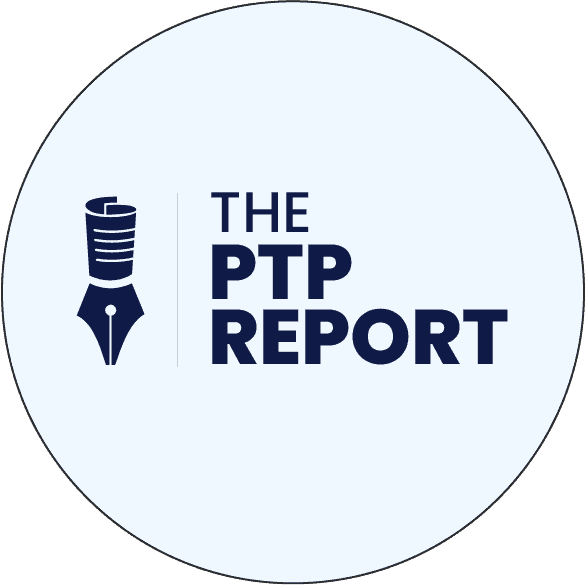Last year, US organizations created 40 top AI models, according to the Stanford HAI 2025 AI Index Report.
China produced 15, and Europe three.
Even more strikingly, the top Chinese models have surged on the major benchmarks, reaching near parity with US models, while China continues to lead on publications and patents, and organizations in the Middle East, Latin America, and Southeast Asia have all contributed their own notable model launches.
And while the US still leads in AI, global infrastructure investment, use, and education is surging.
As Nvidia CEO Jensen Huang said in a statement last week:
“AI inference token generation has surged tenfold in just one year, and as AI agents become mainstream, the demand for AI computing will accelerate. Countries around the world are recognizing AI as essential infrastructure—just like electricity and the internet…”
In today’s PTP Report, we look at this recent surge in global AI investments and their impact on IT sourcing.
Global AI Investment Trends in the News (Again)
Private investments in AI reached some $109 billion last year in the US alone, and as pointed out by the Stanford report, this was nearly 12 times China’s $9.3 billion and 24 times the $4.5 billion invested by the UK.
In fact, if you total all the private investments made from the next 14 nations (after the US) from 2024, you get to (nearly) $36 billion.
But while US private investors continue to dominate the AI expenditure, China is increasing its own infrastructure spend ($47 billion+ for semiconductors, with an estimated 50% self-sufficiency this year).
France has committed 109 billion Euros, Canada $2.4 billion, India $1.25 billion, and with the US government reversing course on what nations are allowed to buy and utilize top chips, recent months have seen enormous pledges by nations in the Middle East.
The White House recently published its own list of foreign investments, including the following:

Offloading Capex: Global AI Spend Outsourcing Surges
In May, Saudi Arabia launched Humain, an AI company under the kingdom’s Private Investment Fund that’s focused on becoming a global AI hub. It will develop next-gen AI technology, cloud infrastructure, and leading Arabic-language LLMs, and Nvidia expects to provide hundreds of thousands of GPUs to the company over the next five years.
These announcements coincided with the visit of the US president and leaders of several top tech firms, with additional deals including some $12 billion in expected regional data center investments.
American companies like Salesforce ($500 million investment planned), Amazon-backed Scale AI, Google, Nvidia, Qualcomm, and IBM have committed to AI-related investments in the region.
At the same time as the visit, Bloomberg reported that OpenAI and Oracle had reached agreement to build one of the world’s largest data centers in the United Arab Emirates (UAE). With a size expected to reach some 10 square miles, the data center would use as much power as five nuclear reactors.
MGX, through the UAE, could also be utilizing the data center, which would be part of the Stargate project. The data center is just one of the UAE AI investments, which could involve the sale of more than million high-end Nvidia chips.
As Bernstein analyst Stacy Rasgon wrote in an investor note:
“For investors worried about AI capex sustainability, we now have another deep pocketed customer willing and capable to spend large amounts of money on a clearly strategic push as Saudi Arabia attempts to position itself as a regional and global AI hub.”
Global AI as Essential Infrastructure
The reversal of a Biden-era policy of restricting the sale of high-end chips comes with the goal of integrating American products and companies into AI systems worldwide, ahead of Chinese efforts.
And while some 85% of the chips deployed in the UAE, for example, are earmarked for data centers operated by American companies, the moves are part of an ongoing increase in global AI compute.
It’s also an effort to tap into available power and resources.
[Check out this newsletter from our Founder and CEO for more on the growing power demands of AI.]
This distribution of data centers accompanies a rise in global AI optimism. According to the AI Index Report, people in China (83%), Indonesia (80%), and Thailand (77%) see AI as far more beneficial than harmful, a sharp contrast to the US (39%).
And the numbers are shifting. Germany and France (+10%), and Canada and Great Britain (+8%) are seeing optimism grow in their population, further indication of AI’s spreading influence worldwide.
In terms of education, two-thirds of countries globally either offer or plan to offer K–12 education in CS, with Africa and Latin America making the most progress.
In the US, 81% of K–12 CS instructors believe AI should be part of their education, though less than half of them believe they have the equipment and knowledge needed to teach it.
In terms of the companies deploying AI by nation, India leads the world, though the UAE, Singapore, and China aren’t far behind:

So, while private investors and companies from the US continue to dominate in investments and production of the newest AI technologies, all signs point to the technology being adopted rapidly, institutionally, worldwide.
IT Budgets and AI: Needing More for Less
The cost of AI proliferation is also hitting IT services worldwide.
And as a result, the traditional sourcing model that saw lower-skilled tech work being offshored with higher value R&D kept local is being rapidly upended.
AI’s efficiency gains come at a cost, which ironically sees some IT budgets squeezed at the same time that current AI benefits aid lower-skilled workers most.
[For a detailed look at this research, check out our PTP Report on the AI impact being seen in nearshore outsourcing.]
From reports that AI may be behind reduced employment rates among new college graduates in the US to increased productivity demands from Amazon coders to the AI-first movement of companies like Shopify and Duolingo, companies are increasingly expecting (or needing financially) to get more from less.
The Rise in Nearshore AI Solutions
With a global rise in AI access, optimism, and familiarity, along with a changed need from what buyers want from outsourcing partners, nearshore outsourcing is having a big moment.
With the capacity to handle Agile workflows with real-time collaboration, companies are exploring alternate sources for their outsourcing needs.
From the US, offshoring from India and Southeast Asia for example still offers deeper talent pools and lower costs (as well as the potential for follow-the-sun coverage, depending on needs), its limitations in an AI-first world can be more troublesome.
From time lost to mismatched time zones to increased security concerns to American government policy, proximity, with its added adaptability, is more appealing for many companies.
The combination of growing AI and network infrastructure, education, and partnerships with American firms is seeing countries like Mexico, Colombia, Argentina, Brazil, and Costa Rica enjoying some of the largest growths.
There is also undeniable appeal in forming data partnerships with US-friendly nations.
A Look at PTP’s Allshores Approach: Nearshore vs Offshore AI Talent
At PTP, we have close to three decades of experience in providing the best tech talent solutions, whether your needs are local, remote, offshore, or nearshore—onsite or off.
And with the ongoing surge in global AI scaling, we see more and more customers taking advantage of nearshore offerings to pair with their on-site teams, for better fit, real-time collaboration, and partnerships that are closer to home.
Whatever your specific needs, give PTP a look. We’re helping customers get up to speed on AI in a number of ways and are always ready to discuss your specific requirements.
Conclusion
While it remains to be seen if surging investments worldwide will lead to greater tech talent redistribution through AI, things in tech are undoubtedly changing fast.
American companies are joining with foreign nations to build offshore data centers, traditional sourcing relationships are being reconsidered and re-designed, and many entry-level positions appear to be getting harder to come by for workers.
There is also ample evidence that AI is being treated more like essential infrastructure than an optional technological upgrade for many nations, and this will continue to impact how companies worldwide find, develop, and utilize talent.
While the long-term outlook for AI as a leveler and bringer of knowledge remains intriguing, in the short-term it is benefitting those who most strategically seize on it for a competitive advantage.
References
The AI Index 2025 Annual Report, AI Index Steering Committee, Institute for Human-Centered AI, Stanford University
Nvidia beats on Q1 revenue, warns of $8 billion sales hit in Q2 from H20 export ban, Yahoo Finance
What’s happening in China’s semiconductor industry?, Economics Observatory
Trump’s Middle East dealmaking could reshape the global AI race, Financial Times
HUMAIN: Saudi Arabia’s bold bet on sovereign AI and Arabic LLMs, CIO
OpenAI, Oracle to Help UAE Develop Massive Data Center, Bloomberg
For Some Recent Graduates, the A.I. Job Apocalypse May Already Be Here, The New York Times
FAQs
Why are US companies shifting some of their AI investments abroad?
AI investments by the big tech companies remain very high domestically, as well as abroad. But the surge in demand for compute is outpacing the capacity of local power grids, and availability of resources like land and water required for cooling. With the demand for AI growing fast alongside bigger, more capable models, partnerships abroad make sense for businesses seeking to ensure data center capacity won’t be a bottleneck in the AI race.
Many of these investments in the recent news are not near to the US. Why is nearshore outsourcing seeing such a boom in 2025?
The two are not directly connected, though Canada and Latin America are also seeing surges in AI investment, education, and optimism among local populations, along with the creation of their own models.
With a move to AI-first policies, companies are seeking greater collaboration capacity than traditional sourcing models allow. Coupled with American government policies, this has made nearshore locations to the US appealing for businesses needing ready labor to help them implement AI or take advantage of AI-augmented workflows.
As more nations treat AI as a necessary infrastructure (like power and water), they are gaining fast in readiness.
What regions are emerging as the strongest players in AI-driven services?
The US remains the leader in R&D and innovation in the field, with arguably the greatest amount of expertise and ready experience on hand.
But China leads the world in AI patents and is coming on fast with open-source, lower-cost models, often using less sophisticated hardware. Indian companies have some of the world’s highest adoption rates, though IT deal pricing is feeling the squeeze in many cases due to rising IT budgets. Many Latin American countries are seeing stronger momentum as a result.
Several nations in the Middle East are also seeking to become global AI hubs, taking advantage of changes in US government policy that are trying to boost US tech ahead of Chinese in the region.





